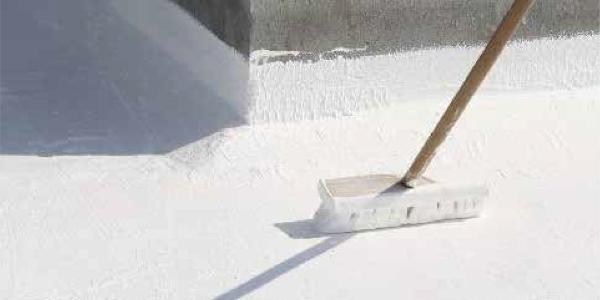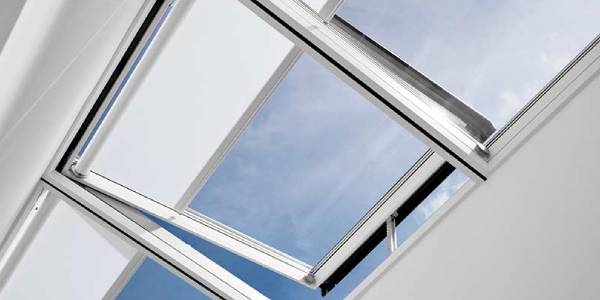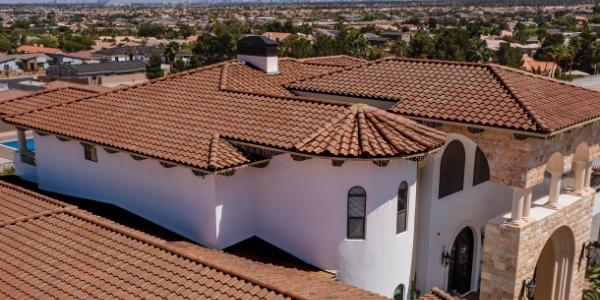Essential guide to evaluating roof coatings

By Jennifer Stephan, Benchmark Inc.
Discover the advantages and disadvantages of different roof coatings and their uses.
Introduction
The roofing industry is currently grappling with persistent supply chain disruptions, material shortages and rising costs. These challenges are driving many property owners to seek ways to prolong the life of their low-slope roof systems through repair, recovery and coating options. While budget-friendly solutions may seem attractive, it is vital to thoroughly assess each option to find the most suitable approach. Therefore, setting clear goals and expectations before undertaking any maintenance or enhancement projects is essential.
For decades, coating systems have been a key element in managing built-up and modified bitumen roofing systems. Although less common for single-ply roofs given the historically lower costs of membrane replacement, the recent volatility in prices and material shortages have made coatings an increasingly viable option. Over the past 20 years, elastomeric coatings have been widely promoted for metal roof restoration, though often unnecessarily so when targeted repairs would be more fitting. It’s important to note that coatings are not a catch-all solution; they cannot convert a deteriorated roof into a long-term asset or serve as a cheap alternative to replacement. However, in certain situations, coatings can effectively extend the life of a declining yet functional low slope roof system. Our team at Benchmark Inc. has provided a guide to aid in the process of determining which options are best for your needs.
Some advantages to coating an existing roof system include:
- Provide protection against water intrusion and slow the deterioration of an aging, but still functional, roof system.
- A reflective coating can reduce energy use by decreasing the heat absorbed by a dark roof surface in warm sunny climates. In southern climates, highly reflective membranes or coatings are required to reflect light and heat away from buildings. Reducing the roof temperature will slow the membrane aging process and prolong the service life.
- A coating will protect an aging membrane against further deterioration from UV exposure. The coating can reduce the thermal expansion and contraction of the existing roof membrane and by limiting the movement, slow further deterioration.
- Coatings are necessary for maintaining roof systems that had a surfacing installed during their original construction, but with a service life known to be shorter than that of the roof membrane. Examples include smooth-surfaced built-up roof (BUR) systems with an aluminum or elastomeric coating system applied, a sprayed polyurethane foam roof system or a black EPDM membrane with a reflective coating applied.
- For a repairable-but-rusting metal roof, a proper coating approach can prolong the roof's serviceable lifespan. If roof panels are corroded but repairs to critical details can restore long-term watertight integrity, it is generally appropriate to combine repairs with a paint or asphalt-based reflective coating system, to protect the rusting steel from further deterioration. Elastomeric coating systems are less desirable for metal roofs, as loss of adhesion and entrapment of water/concealed corrosion can occur.
- Coatings can be used to temporarily patch a failing roof membrane. If budget shortfalls or other concerns are prolonging repairs or replacement, coatings can be a quick, "band-aid" fix to minimize leaks until capital funding is available for roof replacement.
- May reduce the impact to interior operations during peak production periods or other critical times, when interruptions associated with roof replacement projects cannot be tolerated.
- Wider availability of material when other options are experiencing longer material lead times.
- Low initial cost compared to reroofing if completed at the appropriate time(s) in the roof's lifecycle. Coating can reduce the total cost of ownership by extending service life.
Owners and facility managers should consider several disadvantages before opting for a roof coating:
- Successful performance depends on the existing roof substrate, project location, existing roof type, slope and exposure to heat, chemicals and UV radiation.
- Coating application and curing is often sensitive to temperature, humidity, dew point and other weather-related factors. Coatings should only be applied and cured when conditions meet the parameters listed in the manufacturer's application guidelines.
- Coating performance is directly related to the condition of the substrate it is applied to (existing roof membrane, base flashings, penetration flashings, etc.) and the skill of the company hired to apply the system. Proper and successful coating application requires careful preparation of the substrate. Incomplete or improper preparation can undermine the entire coating application.
- Coating must be compatible with the existing coatings and/or roof membrane. Adhesion testing should be performed to identify which products will adhere and to exclude those that will not. Previous repair materials may have to be fully removed if the applied materials are not an acceptable substrate for the selected roof coating.
- Coatings are not advised without confirming the roof is either dry or repairable. Moisture trapped in the roof can add weight, deteriorate the deck and in some cases deteriorate the structural roof framing system. A moisture survey is recommended to identify areas of wet insulation, the results of which should be used to decide if coating is viable and to identify repair areas if applicable.
- Failed areas of the existing roof system, including leak areas and wet substrate materials, must be removed and replaced with dry, sound materials to properly support the new coating system. The roof's attachment has already been compromised in these areas and coating alone will not restore the roof's function. If coating is installed over existing moisture-laden roof insulation, the roof will remain unstable and the new coating will most likely blister and fail.
- Elastomeric coating systems over metal roof systems are rarely recommended, as leaks originate from the end laps, side laps, flashing details and other localized sources. The field of the metal panel is rarely the cause of leaks and covering the other areas can allow trapped moisture beneath the repair materials to corrode the panels. This may not be discovered until rust stains are seen running out of the edges of the repairs. Repair procedures should not block drainage at end laps.
- While a roof coating may prevent water from penetrating and damaging the existing low slope or steep slope roof system, many coatings degrade or peel-up when exposed to standing water. Ponded water, especially when combined with heating from UV exposure, can lead to the breakdown of the coating, delamination and eventual deterioration of the coating. Ponding can encourage organic growth of mold and mildew. Ponding also presents challenges in achieving proper adhesion for many coating systems. Only consider coatings that will perform with standing water in conjunction with UV exposure - without delaminating, peeling or deteriorating.
- Drainage is a key consideration. Although certain types of coatings can perform on roofs that pond water, poor drainage will cause accelerated deterioration of many coatings and significantly shorten the performance period.
- Some roof coating materials tend to attract and hold dirt and contaminants on the roof surface, which results in loss of reflectivity and increasing roof temperatures over time. The darkened color raises heat absorption and can diminish the roof's appearance.
- Coatings are often considered an economical way of increasing a roof's reflectivity to reduce cooling costs. However, the return on the investment in a coating application may be so slight that the energy cost savings never approaches the cost of the coating application. A coating is not always necessary if enough thermal insulation is installed within the existing roof system, which negates the need for a coating to help cool a roof in hot climates.
- Coatings aren't always the most economical option. For many low slope roof applications, a single-ply membrane recovery may be more economical than a roof coating installation and provides for a longer anticipated service life.
- Many manufacturers are now promoting extended coating warranties to attract potential buyers, in some cases providing 20+ years of coverage. In our experience, performance life and warranty term are not necessarily equal. Owners should take into consideration the maintenance and care needed to allow the system to perform throughout the warranty term. Many of these warranties cover the cost of new material only and exclude costs of existing roof preparation and coating application. As with all warranties, it is important to understand the coverage provided and stated exclusions.
Types of roof coatings
Roof coatings are generally divided into two main categories:
- Asphaltic coatings are typically made of asphalt or bitumen and are designed to be used on asphaltic roof membranes. Asphaltic coatings cannot adapt well to fluctuations in temperature. Aluminum coatings are typically modified asphalt based with suspended aluminum flake that provides UV protection, appropriate for most modified bitumen and built-up roof systems. Aluminum coatings may also be applied to metal roof systems.
- Elastomeric coatings are commonly made using acrylic, polyurethane or silicone. Elastomeric roof coatings can expand and contract with the roof to respond to fluctuating temperatures and are compatible with a wide range of substrates.
Each type of coating has unique attributes that make it suitable for some specific projects, but unsuitable for others. There is not a single product that will be the best choice for all situations. Below we list some of the key strengths and weaknesses of the three types of elastomeric roof coatings.
Acrylic roof coatings (Anticipated service life: Five to ten years*)
* Depending on chemistry, application and maintenance
|
Strengths: |
Weaknesses: |
|
|
Polyurethane roof coatings (Anticipated service life: Seven to ten years)
|
Strengths: |
Weaknesses: |
|
|
Note: Polyurethane roof coatings come in two types, aliphatic and aromatic. Aliphatic roof coatings are more expensive, UV stable, remain cleaner and hold color well. Aromatic coatings are less expensive, not UV stable, often used as a base coating.
Silicone roof coatings (Anticipated service life: Ten to fifteen years)
|
Strengths: |
Weaknesses: |
|
|
Summary
Some existing roof systems can benefit from a roof coating, but in other cases, coatings aren't a wise investment; the benefits simply do not outweigh the required expenditure and the potential risk of an unsuccessful outcome.
However, if conditions and timing are right, coatings can be a good option to extend the service life of an existing low slope roof system. There are ways to increase the longevity of a coating system, such as with adding reinforcement and multiple coats. But even with those enhancements, performance beyond 10 years will require some maintenance and possibly a future additional topcoat application. Some companies do indicate a much longer life expectancy and/or warranty for the first application, but as noted above, the performance is dependent on many factors that are sometimes beyond the control of the coating manufacturer and applicator.
Original article source: Benchmark Inc
Learn more about Benchmark in their Coffee Shop Directory or visit www.benchmark-inc.com.





















Comments
Leave a Reply
Have an account? Login to leave a comment!
Sign In